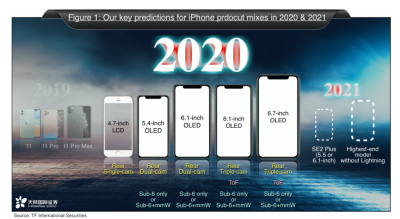Unlike in the past when phone makers were trying to make their phones thinner and slimmer for aesthetic reason, the smartphone of today seems to have gotten bigger and bulkier and weightier then ever before.
Instead of a thin chassis, the focus has now shifted to bigger, beefier batteries, glass backs and larger camera sensors, which inevitably results in the phones becoming bulkier and thicker in order to accommodate the bigger batteries and bigger sensors.
iPhones have been becoming thicker
The iPhone which started off as a thick sandwich initially (take the iPhone 4 for example) became one of the thinnest smartphones with the arrival of the iPhone 6. Things were looking good until the iPhone X came out in 2017. While it did have a bigger battery and all that but the iPhone X added some extra millimeters to its thickness.


But it was still a pretty sleek device at 7.7mm thick, until the current iteration iPhone 11 Pro came out with an 8.1mm thick chassis. The iPhone XR and iPhone 11 are among the chubbiest members of the iPhone family at 8.3mm thick. However, all this is set to change and we could see the iPhone go back to the iPhone 6-like slimness thanks to a new screen technology that will help Apple cut a few millimeters off of the upcoming iPhone 12's waistline.
New screen tech will help iPhones get back in shape
If we take all the rumors and speculations surrounding the iPhone 12 into account, it sure looks like the 2020 iPhones could be the most substantial upgrade to the iPhone since the iPhone X. After rumors that Apple could ditch the iPhone notch for good, now a new piece of information has emerged from the supply chain, and it points to a new type of display technology that will help make the iPhone 12 slimmer.
We already know that at least some of the iPhone 12 models (Apple is rumored to launch 6 different iPhones this year) will come with OLED panels manufactured by LG. A report by The Elec, suggests that these screens will have touchscreen circuity embedded in the display itself, rather than spread out on a separate layer, which used to be the case with earlier iPhone displays. This technology translates to cheaper and thinner screen, which leads to a thinner overall iPhone 12.
Always-on display for 2020 iPhones
The report also suggest that LG will be switching to the same low temperature polycrystalline oxide (LTPO) screen technology that is used in the always on display of the Apple Watch Series 5, meaning that the iPhone 12 display will be more power efficient as well.
The LTPO display technology helps the Apple Watch Series 5 deliver all-day battery life despite the always-on display. So, it seems that the iPhone 12 may have an even better battery life than the iPhone 11. Not to mention, the tech might even be used to enable the option of an always-on display on future iPhones, a feature that we are yet to see on the iPhones but is available on some high-end Android smartphones.
However, the only caveat is that we're not sure if the LTPO tech will be ready in time for the 2020 iPhones. So, we suggest you don't get your hopes too high because always-on displays could be reserved for 2021 iPhones.
We might finally get to see iPhone SE 2
Meanwhile, Apple is rumored to be launching at least six new iPhones this year, including four iPhone 12 models and two iPhone SE 2 models. The long-rumored iPhone SE 2 might finally make it to the consumers this year and it will reportedly be joined by a bigger sibling. If the rumors turn out to be true, this year will be one of the most exciting years for Apple fans.









